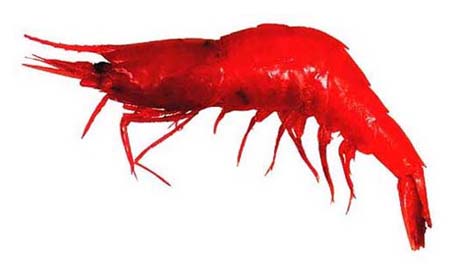ヒオドシエビ科
- HOME
- デジタル図鑑
- パタゴニア海域の重要水族
- 節足動物門 甲殻綱 十脚目
- ヒオドシエビ科
ヒオドシエビ科(Oplophoridae)

131 ホンヒオドシエビ(Hon-hiodoshiebi)
Acanthephyra pelagica(Risso, 1816)
特 徴:
体長12 cm。頭胸甲が強く側扁している深海性のエビで,頭胸甲,腹甲ともあまり硬くないが,光沢がある。小さな触角上棘とやや大きな鰓前棘があり,後者からは頭胸甲の前1/4ほどまで強い稜が走る。背面から見ると,鰓前棘に至る稜は斜め外方に向かっている。眼窩底部と触角上棘の後方に浅く短い縦溝があり,また,触角上棘の斜め下方から,鰓前棘からの縦走稜後端まで線状の溝が斜めに走る。その交点より斜め後上方からごく鈍い稜が頭胸甲を斜めに横切る。額角は頭胸甲とほぼ等長で,ごく弱く湾曲する。上縁には9,10本,下縁には5,6本のとげがある。額角の後半部は側面が稜をなし,頭胸甲の前1/5ほどまで達する。頭胸甲の正中稜は頭胸甲の後縁近くに達する。第2〜第6腹節まで背正中線は鋭い稜をなし,第3〜第6腹節では稜の後端がほぼ同大の棘状歯に終わる。尾節は細く第6腹節とほぼ等長で,背正中部が溝になる。側縁には7〜11対のとげが並んでいる。胸脚は細く,前2対がはさみをもつ。第2対は第1対より長く,長節末端に長いとげが1本ある。第3,第4対までは長節と座節に多数のとげが並ぶが,第5対では長節にのみ数本の小さなとげがある。
分 布:
著しく分布が広いが,記録は必ずしも連続していない。分布範囲は,北東大西洋・アイスランド近海から地中海を経て南東大西洋・南アフリカおよび南西大西洋・アルゼンチン南部まで。その他,インド洋および太平洋の南緯32度から57度の間にも分布している。水深150〜3,600 m。
備 考:
額角の形態や腹節の正中稜の形状は,やはり広く分布するヒオドシエビによく似ているが,尾節の背側縁のとげが3〜6対に対して7〜11対である。
文 献:
Sivertsen and Holthuis (1956); Boschi (1973); Kensley (1980).
(武田正倫)
Material examined:
FSFL EM287 (2♂♂,3♀♀-39°30′S, 54°57′W, 1,222 m deep; June 7, 1978); EM209, EM210 (2♂♂, 5 ovig. ♀♀, 4♀♀-40°31′S, 56°24′ W, 800 m deep; June 30, 1978). Total length from tip of rostrum to posterior margin of telson, 12 and 13.5 cm in a male and a female (EM287), respectively.
Description:
A bathypelagic, strongly compressed species. Carapace smooth and polished, not hard; a small antennal and a large branchiostegal spines present, a short, strong longitudinal ridge running from branchiostegal spine; in dorsal view branchiostegal spine directed obliquely outward; a very shallow, short longitudinal furrow present behind orbit and a linear oblique furrow below it. Rostrum as long as carapace, weakly curving upward, and armed with 9 or 10 upper and 5 or 6 lower suberect spines; posterior half of lateral surface of rostrum narrowly ridged and extended back onto anterior fifth of carapace; median ridge of rostrum almost reaching to posterior margin of carapace. Second to sixth abdominal segments strongly ridged dorsally, and each posterior end of third to sixth segments produced to be a spiniform tooth. Telson narrow, being armed dorsolateterally with 7-11 spines. First 2 pairs of pereiopods chelate; second pair longer than the first, and merus armed with a long spine at its distal end; in third and fourth pairs ischia and meri armed with many spines, but those of fifth pair only with sparse small spines.
Distribution:
East Atlantic from the vicinity of Iceland through the Mediterranean to South Africa, the Southwest Atlantic, and the Indo-Pacific between 32° and 57°; 150-3,600 m deep.
Remarks:
The general shape of the carapace is very similar to that of A. eximia Smith but distinguished from it most remarkably by having 7-11 dorsolateral spines on the telson instead of 3-5.
(Masatsune TAKEDA)

Distribution of Acanthephyra pelagica in Patagonia.
- 1